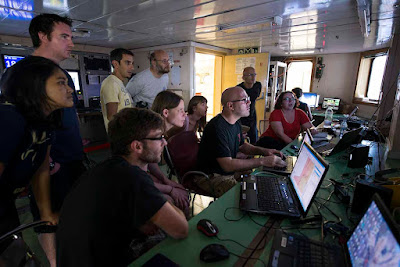Hello all,
We hope you are well.
We apologise for our silence
in the past two weeks. On the last day of the CUMECS cruise we were very busy
with preparing for disembarkation, making data back ups and clearing the
laboratories. And after disembarkation, some of the cruise participants headed back
home whereas others attended workshops and conferences across Europe .
We are very happy with the
CUMECS cruise and we think it was a great success. Our young team (with average
age of 32 years) worked really well. We managed to obtain more data than we
hoped for, and we discovered some really interesting features along the
Malta-Sicily Escarpment.
The multibeam echosounder
data allowed us to identify numerous submarine landslides that extend from the
canyon head towards the continental shelf. The seismic data provided
information on the nature and depth of these landslides as well as the presence
of buried channels upslope of the canyon heads. We obtained 9 sediment cores
that should allow us to determine the nature and age of the landslides, as well
as the history of flow activity into the canyon head. The ROV survey, on the
other hand, provided evidence of deep water coral communities, as well as human
disturbance, in the canyon heads.
The CUMECS cruise may be
over, but our work is not. The next phase of our project will involve
processing and analysing the acoustic and sedimentological data acquired during
the expedition. We will generate detailed 3D models of the seafloor and 2D
images of the sub-seafloor to understand the evolution of the Malta-Sicily
Escarpment in the past. We will also use these data to test predictive habitat mapping
techniques. We plan to investigate the sediment cores in the laboratory to
determine the nature, origin, age and frequency of landslides and flows within
the canyons. And, finally, we will watch the ROV footage again to identify and
map benthic habitats and biota in detail.
When all the analyses are completed, we will produce articles that will
be reviewed by scientific experts in the field and published in international scientific
journals. We also plan to present the results of our study at a number of international
conferences.
And for the general public, we will produce a documentary that will be
uploaded on YouTube and shown at secondary schools.
At this point, we would like to particularly thank the Eurofleets
project for making this research cruise possible, and the captain and crew of
the R/V Urania, who were so professional, efficient and fun to work with.
And we would also like to thank you for following us from all over the
world, and we hope that you can join us on our next adventure!
The CUMECS Team













